Buff (colour)
| ||||||||||||||||||
| ||||||||||||||||||
Buff is the pale yellow-brown colour of the un-dyed leather of several animals.[2]
As an RYB quaternary colour, it is the darker colour produced by an equal mix of the tertiary colours citron and russet.[3]
Etymology
| Look up buff in Wiktionary, the free dictionary. |
The first recorded use of the word "buff" to describe a colour was in the London Gazette of 1686, describing a uniform to be "...a Red Coat with a Buff-colour'd lining".[4] It referred to the colour of un-dyed buffalo leather, such as soldiers wore as some protection: an eye-witness to the death in the battle of Edgehill (1642) of Sir Edmund Verney noted "he would neither put on armor or buff coat the day of the battle".[5] Such buff leather was suitable for buffing or serving as a buffer between polished objects. It is not clear which bovine "buffalo" referred to, but it may not have been any of the animals called "buffalo" today.[6]
Derived terms
The word "buff" meaning "enthusiast" or "expert" derives from the colour "buff", specifically from the buff-coloured uniform facings of 19th-century New York City volunteer firemen, who inspired partisan followers among particularly keen fire-watchers.[7]
In nature
Geology
Sand, rock, and loess tend to be buff in many areas.
-
Buff sand
-

Buff rock at the top of a cliff
-

Buff loess
Natural selection
Because buff is effective in camouflage, it is often naturally selected. In bird descriptions the colour is often referred to as "buffy".
-
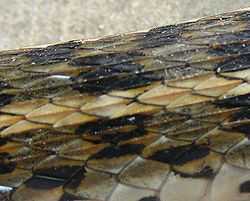
Buff bands on a snake.
-

A moth with buff wingtips (Phalera bucephala).
-
The buff wingtips of this moth aid in camouflage.
-

Buff fungi
Many species are named for their buff markings, including the buff arches moth, the buff-bellied climbing mouse, and at least sixty birds, including the buff-fronted quail-dove, the buff-vented bulbul, and the buff-spotted flufftail.
-
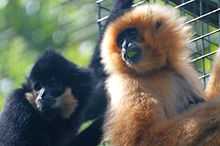
A pair of northern buffed-cheeked gibbons
-
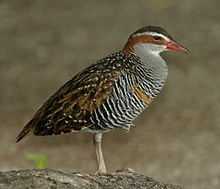
The buff-banded rail
-

The buff-necked ibis
In culture
Architecture
In areas where buff raw materials are available, buff walls and buildings may be found.
-

Traditional buff stone buildings
-
_-_geograph.org.uk_-_934243.jpg)
Modern buff brick buildings (centre)
Stationery and art
Unless bleached or dyed, paper products, such as Manila paper, tend to be buff. Buff envelopes are used extensively in commercial mailings.
-

Manila paper
-
Buff envelopes
Buff paper is sometimes favoured by artists seeking a neutral background colour for drawings, especially those featuring the colour white.
-

Red and white chalk portrait on buff paper.
-

Black chalk with brown wash, heightened with white on buff paper
-

Graphite drawing with watercolour wash on buff paper
Artificial selection
Buff domesticated animals and plants have been created, including dogs, cats, and poultry. The word "buff" is used in written standards of several breeds, and some, such as the Buff turkey, are specifically named "buff".
-

A buff gun dog
-

A buff mousing cat
-

A buff chicken
-

The Buff Orpington Duck
-

The rose cultivar 'Buff Beauty'.
Clothing
Waistcoats
In 16th and 17th century European cultures, buff waistcoats ("vests" in American English), were considered proper casual wear.
-

17th Century English musician wearing a buff waistcoat.
Boots
In the 17th century, the traditional colour of formal dress boot uppers was often described as "buff".
-
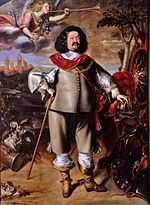
17th Century Italian Nobleman wearing buff dress boot uppers.
John Bull
Clothing depicted on John Bull, a national personification of Britain in general and England in particular,[8] in political cartoons and similar graphic works, has often been buff-coloured.[9] Bull's buff waistcoats, topcoats,[10] trousers[11] and boot uppers[12] were typical of sixteenth- and seventeenth-century Englishmen.[10]
-

Early depiction of John Bull with the buff clothing typical of a 16th-century Englishman.
-
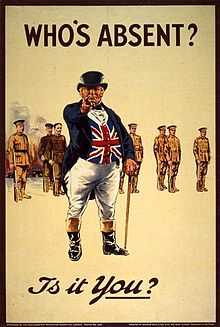
John Bull wearing buff dress boot uppers.
-

John Bull wearing buff trousers
Seventeenth-century military uniforms
Buff is a traditional European military uniform colour. Buff has good camouflage qualities as sand, soil, and dry vegetation are buff in many areas.
-

Buff German uniforms
-

Dry vegetation in Europe
"Buff coat"
The term "Buff coat" refers to a part of 17th-century European military uniforms. Such coats were intended to protect the wearer, and the strongest and finest leathers tend to be buff, so the term "buff coats" came to refer to all such coats, even if the colour varied.
The British army
The Royal East Kent Regiment was nicknamed "The Buffs" from the colour of their waistcoats.
-
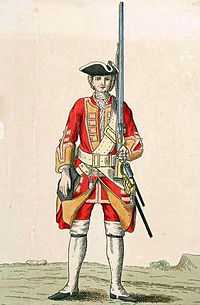
Soldier of The Buffs (Royal East Kent Regiment) wearing "a new Red Coat lin'd with a Buff colour'd lining, .... Breeches of the same colour as the Coat lining."
The U.S. Army
The uniform of American Continental Army was buff and blue.
Buff is the traditional colour of the U.S. Army Quartermaster Corps.
The U.S. Army Institute of Heraldry specifies a "buff" tincture for certain coats of arms.
-

Continental Army uniforms: "The Buff and Blue"
-

US Chevron - Quartermaster Sergeant Insignia (1902-1909) Buff on black with blue detail.
-

USAIH illustration which specifies "...a buff colored vertical rectangular embroidered item..."
U.S. universities, fraternities and schools
The colours of The George Washington University and Hamilton College are "buff and blue", modelled on the military uniform of General George Washington and the continental army. Both General Washington and Alexander Hamilton, as Chief of Staff, had a role in the design of the uniforms.
Other school colours described as "buff and blue" include Gallaudet University in Washington, D.C., and Punahou School in Honolulu, Hawaii.
Buff is one of three colours of the Alpha Gamma Delta fraternity, and one of two colours of the Delta Chi fraternity.
-

General Washington wearing The Buff and Blue
-

George Washington University banners featuring The Buff and Blue
-

The Buff and Blue logo of the George Washington University Colonials.
U.S. state flags
The flags of Delaware and New Jersey, and former flags of New York and Maine, officially include "buff".
-
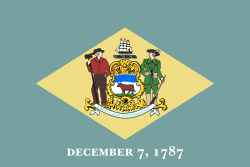
The Flag of the State of Delaware includes "a background of colonial blue surrounding a diamond of buff".
-
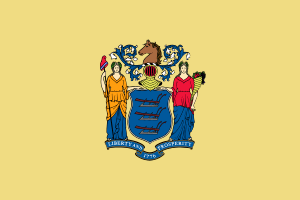
The Flag of the State of New Jersey has "the State seal ... in Jersey blue on a buff background"
-
.svg.png)
Former flag of the State of New York (until 1901)
-

Former flag of the State of Maine (until 1901)
UK politics
The colours of the Whigs, an 18th-century British political party, were buff and blue.
-

Depiction of a British Whig wearing buff and blue
White Star buff
The funnels of the RMS Titanic and all other ships of the White Star Line were designated to be "buff with a black top" in order to indicate their ownership. There is some uncertainty among experts, however, as to the exact shade of what is now called "White Star buff". There is no surviving paint or formula, and although there are many painted postcards and at least seven colour photographs of White Star liners, the shades of the funnels in these varies due to many factors including the conditions under which they were originally made and the aging of the pigments in which they were printed. Speaking mostly to scale modellers, the Titanic Research and Modeling Association currently recommend a colour "in the range of the Marschall color", meaning the colour in illustrations in a particular book.[13][14]
-

Ships of the White Star Line, such as this one and the Titanic, had buff funnels with black tops.
See also
References
- ↑ RGB approximations of RYB tertiary colours, using cubic interpolation. The colours displayed here are substantially paler than the true colours a mixture of paints would produce.
- ↑ Paterson, Ian (2003), A Dictionary of Colour (1st paperback ed.), London: Thorogood (published 2004), p. 73, ISBN 1-85418-375-3, OCLC 60411025
- ↑ William J. Miskella, 1928, Practical Color Simplified: A Handbook on Lacquering, Enameling, Coloring And Painting; John Lemos, 1920, "Color Charts for the School Room", in School Arts, vol. 19, pp 580–584
- ↑ "buff, adj.1". Oxford English Dictionary. OUP. Retrieved 21 April 2011.
- ↑ Miriam Slater, Family Life in the Seventeenth Century: the Verneys of Claydon House1984:11.
- ↑ Barnhart, Robert K. (1995). The Barnhart Concise Dictionary of Etymology: The Origins of American English Words. New York: Harper Collins. p. 90. ISBN 0-06-270084-7.
- ↑ Robert W. Masters "What is a Fire Buff?", Pictorial History of Firefighting', revised edition, 1967; Steve Hanson, "Fire buffs: who are they?".
- ↑ Taylor, Miles (2004; online edn, 2006). "Bull, John (supp. fl. 1712–)". Oxford Dictionary of National Biography. Oxford University Press. doi:10.1093/ref:odnb/68195. Check date values in:
|date=(help) - ↑ "John Bull Running". Sterling Times. Retrieved 7 August 2012.
- ↑ 10.0 10.1 "AngloMania: Tradition and Transgression in British Fashion," Metropolitan Museum of Art (2006), exhibition brochure, p. 2.
- ↑ Matthews, Stella (February 2000). "The Search for John Bull". "Best of British" Magazine. Retrieved 7 September 2012.
while the figure with which we're most familiar, the portly one resplendent in top hat, top boots, buff-coloured trousers, swallow-tailed coat, and sporting the British flag on his waistcoat, was the work of Sir Carruthers Gould as depicted in the Westminster Gazette in the late 1800s and early 1900s.
- ↑ "John Bull and His Bulldog". Gold Posters. Retrieved 7 August 2012.
- ↑ The TRMA recommend the colour on found on "pp. 54, 60-61, and 67 of the new book Art of Titanic", presumably Ken Marschall's Art of Titanic 978-0786864553.
- ↑ Braunschweiger, TRMA, Art. "White Star Buff: Weighing the Evidence". Titanic Research and Modeling Association (TRMA). Retrieved 28 July 2012.
An earlier version of this article appeared on the TRMA website in October 2004 under the title "Photographic and Illustrative Evidence of White Star Buff." In December 2004, the article was rewritten under its present title to reflect new evidence and new debate on the subject since the writing of the original article.
| ||||||||||
| ||||||||||
| ||||||||||||||||||||||||||||||||||||||||





